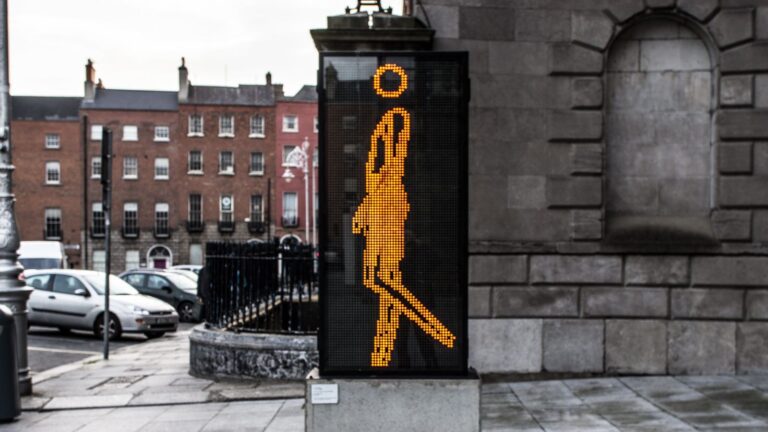Born in 1958, Julian Opie is a famous contemporary artist from London, United Kingdom. Most of his works are displayed in London’s reputable art centers. Despite using other mediums of art, this renowned painter is also known for his sculptures and installation art.
Opie has worked with Michael Craig-Martin after graduating from the University of London-Goldsmiths in 1982. He is also known as a part of the New British Sculpture movement along with Tony Cragg and Anish Kapoor.
His first works were mainly steel sculptures, where he emphasized his own observation of the world. His works often take up themes such as movement, city or daily life activities together with individuals’ relation with their environment. For Opie, he sees the figures around him and gives them another life by simplifying their forms into iconic, almost cartoon-like silhouettes. He strips away the details to focus on the essence of his subjects, using bold outlines and flat, vivid colors. Portraits and animated walking figures, animals, and buildings are rendered with minimal detail in his work.
The artist prefers to steer away from drawing anything particularly special. Instead of focusing on the identities of people and their surroundings, he selects any one that can be perceived as an ordinary person, part of a broader landscape, encouraging the viewers to observe more of the depicted movement and the feeling it arouses. The artist draws inspiration from the moments of boredom in his daily life. For his “Walking” series, Opie would go into the city, photograph people with specific balanced moves in their movement, and then draw them.
His way of using color is very unique, most of his silhouette work have monocoloristic characteristics, and his experience as a color-blind person has led him to work with less colors and imagine each person in their own color. He reflects people’s differences by not only their color but the surface he chooses to reflect them on, whether it’s shiny or matt may cause the viewers to read the art works differently. It is this very simple difference that Opie finds joy in presenting to the viewers. These allow the viewers to capture the movement in the art works more deeply as they move from reflective surfaces to fully matte surfaces.
Starting his work from sculptures, over time, the artist has expanded his practice to include painting, installation, and cover art for albums. Opie was one of the leading artists in his time with his usage of computer software to create graphics, even designing the album cover for the British Band Blur. His simplified perspective of landscapes, cityscapes and roads was exhibited in Birmingham’s Ikon Gallery in 2001. His work can be found in the collections of the Museum of Modern Art in New York, Guangdong Museum of Art, Museum of Contemporary Art in Krakow (MOCAK), Museo de Arte Contemporáneo de Castilla y León (MUSAC); as well as his current open air exhibitions at the Piazza del Quadrilatero in Milano and La Llotja.
Yoshitomo Nara
Born in 1959 in Japan, Yoshitomo Nara’s life was heavily influenced by his studies in Germany before moving back to Japan in 2000. Since the late 1990s, Nara has exhibited his work across Europe, the United States, Japan, and Asia. He is renowned for his powerful portraits featuring gazing eyes, daily drawing works, three-dimensional pieces in various materials, and installations of little houses.
Nara, arguably one of the most famous living Japanese contemporary artists, is best known for his signature images of menacing wide-eyed children. While his initial works were considered close to the Superflat style crafted by Takashi Murakami, Nara’s influences from punk music and exploration of emotions in his art separates him from Murakami, whose work is more vibrant and pop-culture inspired.
Nara draws inspiration from various cultural sources such as Japanese children’s book illustrations. As a teenager, Nara was heavily influenced by music, collecting records from smaller labels and constantly playing music in his room. His imagination was a way of getting over the language barrier when listening to music, as his studies in Germany proved further about his ability to overcome this struggle. His works transcend language barriers and cultural differences.
The artist tries to confront and interpret the true nature of people’s hearts, resulting in works that are like mirrors to the viewers. The rebellious undertones in his paintings have attracted many viewers who feel alienated from society, including troubled youths. His drawings show complex emotions such as fragility, anger and questions about identity.
Nara’s paintings result from a deep introspection, with colors and compositions developed through a process of layering. He uses materials such as paper to reflect his raw emotions and thoughts, free from theoretical constraints. Nara has a strong fan base, and his paintings have sold for great amounts, such as the sale of his work Knife Behind Back (2000) for $25 million at Sotheby’s in Hong Kong in 2019.
Though art critics find it hard to define the essential value found in Nara’s art, his way of intricately expressing many emotions in his children and animal figures seems to allow the viewers to find a relatable comfort in his art.
His work can be found in the permanent installations in Los Angeles County Museum of Art (LACMA), Museum of Fine Arts in Boston, and Aomori Museum of Art.
The artist also has two current exhibitions planned for 2024, in the Penghu Reclamation Hall in Taiwan and the Guggenheim Museum Bilbao in Spain.






